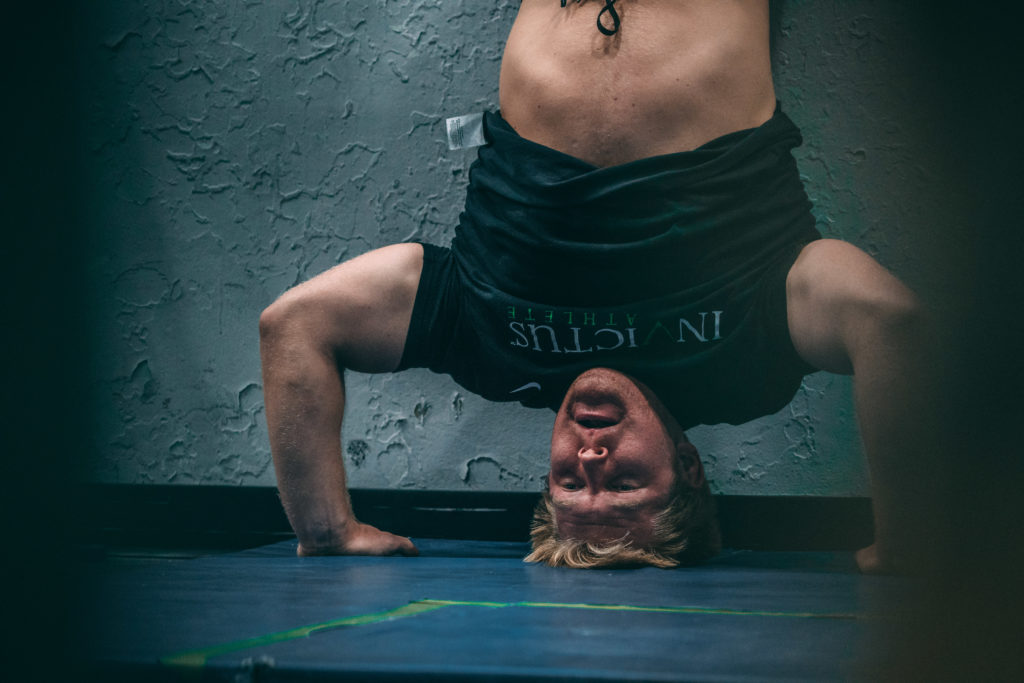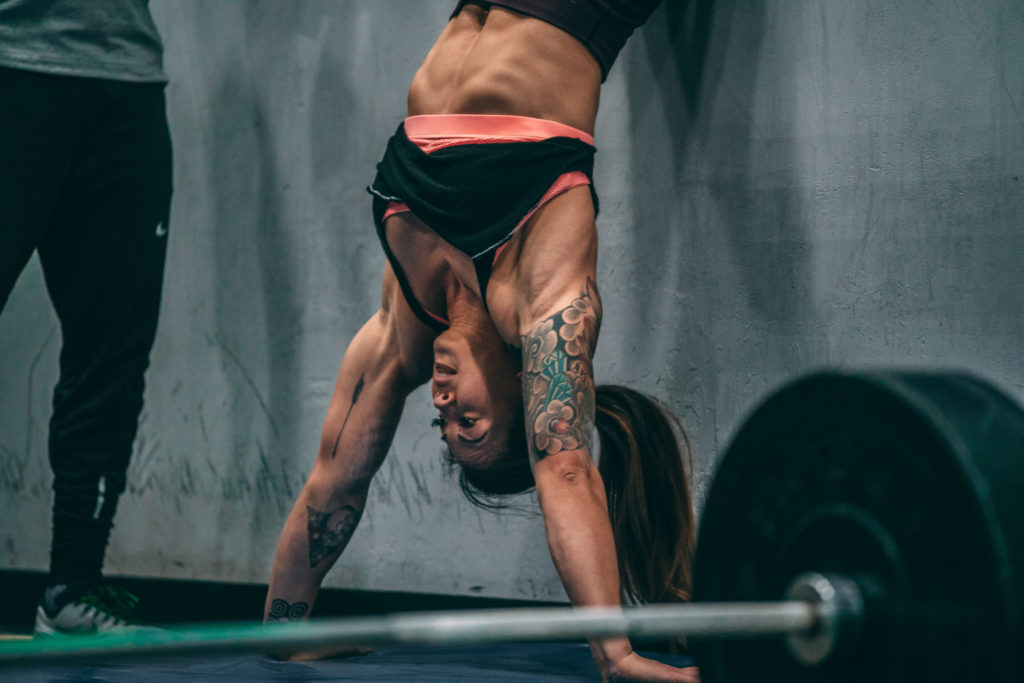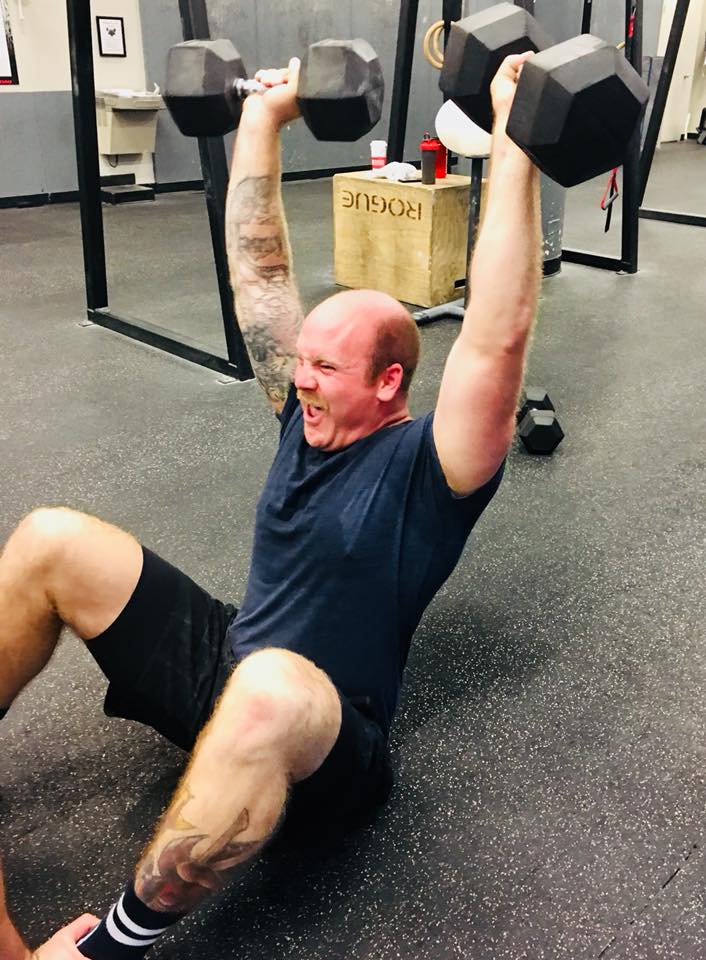
Don’t Have Strict Handstand Pushups? Here’s the Plan…
Written by Nichole DeHart, Brittany Weiss & Michele Vieux
Do you have a hard time doing a proper handstand push-up? Just follow these tips from the coaches at Invictus Fitness to learn how to do them correctly.
Most of our readers would probably have thought, if asked about a year before they began CrossFit, that they would never do a handstand push-up, let alone even think about doing more than one! You’ve probably seen some athletes in the gym knocking out a few handstand push-ups, have seen athletes every year completing these at the CrossFit Games and saw Ryan Gosling (or at least his double) crank out effortless handstand push-ups in Crazy, Stupid Love. So, you might be asking, how can I attain a handstand push-up? Or, if you already have one, how can I improve my technique?
To start, let’s establish a few things you should have before you look to build your Handstand Push-Up (HSPU) prowess. First, you should be comfortable kicking into a handstand against the wall. Become comfortable with being upside down and maintaining a stable position. This stable position should look like the photo above…a straight, rigid line from wrists to ankles.
To obtain a good stable handstand push-up position, think about squeezing your butt and gut tight to maintain a firm midline. Once you have established this position, then you can move forward to the first training phase.
Why is the Strict Handstand Push-up so Important?
We are going to first work on developing a strict handstand push-up. There are many benefits to obtaining a strict handstand push-up. Not only are you making your shoulders stronger and more stable, but you are also forced to maintain a tight, braced midline/core throughout the movement. This piece transfers over to many other CrossFit movements where a strong midline is required to perform the movement efficiently.
Just like you wouldn’t want someone performing a ton of kipping pull-ups when they don’t have the strength to do one strict pull-up, we don’t want someone doing a ton of kipping handstand push-ups if they don’t have the strength to do a strict handstand push-up. The shoulder strength required to complete a handstand push-up is great, and some may not have that strength just yet. Have no fear, we have created a simple training program to help you build your upper body strength to reach the goal of obtaining a strict handstand push-up. With dedication, patience and hard work, you too can successfully attain a strict handstand push-up!
How to DO A Strict Handstand Push-Up:
- Hand placement: place hands about 6-12 inches away from the wall and slightly wider than shoulder width apart. Make sure palms are facing forward, or slightly turned out 5-10 degrees.
- Kick up into a handstand, with your heels touching the wall. If you have trouble kicking up into the handstand, try practicing this donkey kick drill.
- Once you have kicked up, establish a strong, rigid midline position. (see above photo)
- While maintaining this position, lower yourself until the top of your head touches the floor/mat. Try to keep your elbows at a 45 degree angle as you lower.
- Once your head touches the floor, press up with the same tightness you had lowering yourself, until your elbows reach full extension.
The 3 training phases for developing a strict HSPU is listed below. Follow this precisely and do not move onto the next training phase until you are able to complete all the reps and sets at the proper tempo.
First, the exercises:
HSUP Negatives: Kick up into your handstand position. Ensure that your hand placement is approximately 6-12 inches away from the wall and your midline/core is in a tight, stable position. Lower yourself at the assigned tempo until your head touches the floor. Kick off the wall and reset. Make sure to control the descent throughout the entire movement. The tempo should be the same from the start of the negative to the end of the negative. If you are hesitant about the distance you are traveling to the floor, then place an abmat underneath your head to lessen the distance of the descent. As you feel more confident with the negative, remove the abmat(s) until you are reaching the full range of motion.
Handstand Hold: Kick up into your handstand position. Hold for a specific amount of time, maintaining a neutral spine and stable midline/core. Once you feel yourself relax from that tight position, kick off the wall. You can also try a wall-facing hold, which is a little more challenging.
Handstand Push Up with Assist: This is best done with a partner. Have your partner hold onto your ankles. Lower yourself at the assigned tempo and press yourself up. The partner is there to help assist you as you press up, giving as much assistance as needed for you to press out of the handstand.
Wall Walks: Lay flat on the floor with your feet against the wall, hands by your side. Press up to the top of your push up position and take a big step up the wall. Take your other foot and step up the wall so that both feet are pressed into the wall. Ensure that you have a tight midline and, if a tight midline is established, walk your hands and feet up the wall until you make contact with your chest. Maintaining control, begin walking your hands out in front of you while simultaneously walking down the wall until your chest is on the floor. Common mistakes with this movement are generally lose of control on the way down from the wall walk and relaxing the midline. Only walk as far up the wall as your mechanics will allow. Increase the height of your wall climb as strength and mechanics improve.
Wall Runs: Wall runs are alternating, single-arm handstand holds and the time held with each arm can vary depending on the athlete’s ability. Wall runs can be performed facing either toward or away from the wall with the latter being the most difficult. Start in the handstand facing the wall. Keep your glutes and gut tight. You should be in a hollow position with your toes touching the wall, your wrists stacked below your shoulders and your shoulders packed tight into the joint. Slightly shift your weight to your right side and pick up your left hand. Your goal should be to touch your chest and put your hand back down on the ground with control. If you cannot maintain control, walk yourself away from the walk, even as far down as a plank or a pike. If you get to the point where you can easily perform 20 wall runs while facing the wall, you are ready to kick up into the handstand and face the world.

Training Phase 1
- Day 1 – Five Sets of: Handstand Push-Up Negatives x 5 reps @ 30A1; Rest 90 seconds
- Day 2: Four Sets of: Handstand Hold x Max Seconds; Rest 60-90 seconds
- Day 3: Five Sets of: Handstand Push-Up Negatives x 5 reps @ 30A1; Rest 90 seconds
Training Phase 2
- Day 1: Five Sets: Handstand Push-Up Negatives x 5 reps @ 40A1; Rest 90 seconds
- Day 2: Five Sets: Wall Climbs x 3 reps; Rest 90 seconds
- Day 3: Five Sets of: Handstand Push-Up Negatives w/partner assist x 5 reps @ 40A1
Training Phase 3
- Day 1: Five Sets of: Handstand Push-Up Negatives x 5 reps @ 50A1; Rest 90 seconds
- Day 2: Four Sets of: Wall Runs x 5-6 reps; Rest as needed
- Day 3: Five Sets of: Handstand Push-Ups w/partner assist x 5 reps @ 50A1
Be patient with yourself as you work towards your goal of a handstand push-up, and stay consistent on this program!
The Bonus Benefit of Bodyweight Exercises
The benefits of learning how to do bodyweight exercises, such as the handstand pushup, go far beyond shoulder and core strength development. One in particular is the freedom to train anywhere, as you only need a wall to get them done. That mean’s you can do them at home or in a hotel room (when traveling) if you can’t make it to the gym.
Be sure to check out these other movements that don’t need weights, but still pack a punch:
Pull-Ups 101: Everything You Need to Know
How to Get Your First Muscle-Up

How to Modify the Handstand Push-up in Workouts
Bottom line, this is a movement you either have or you don’t. The only way to get them is modifying in ways that are putting you in a strict motion, instead of just always reverting to kipping as a scaling option when they come up in workouts.
Here are some modifications you can incorporate in your training/workouts to help build the strength and muscle endurance to start knocking these out like a champ.
HSPU Negatives: Kick up into your handstand position. Ensure that your hand placement is approximately 6-12 inches away from the wall and your midline/core is in a tight, stable position. Lower yourself at the assigned tempo until your head touches the floor. Kick off the wall and reset. Make sure to control the descent throughout the entire movement. The tempo should be the same from the start of the negative to the end of the negative. If you are hesitant about the distance you are traveling to the floor, then place an abmat underneath your head to lessen the distance of the descent. As you feel more confident with the negative, remove the abmat(s) until you are reaching the full range of motion.
When to use them: Since we are working on a slow and controlled tempo with negatives, they are best NOT used in workouts for “time” rather in gymnastics skill sessions or if HSPU come up in the strength part (usually Part A) of the workout. You might need to start by scaling the number of reps by half, or even more, until you can accumulate longer time under tension and a higher number of reps per set. A goal is HSPU Negatives x 5 @ 51A1 tempo. So that’s a 5-second negative descent; touch your head to the ground for 1 second while maintaining control and not dropping to the head; (A)ssist up which will be either a kick up or a partner assist; and a 1-second hold in the handstand position, maintaining control.
Seated Dumbbell or Barbell Press: Sit yourself down in a “L” position. Your legs should be straight, chest proud, and back is flat. Place the dumbbells in each hand with the top of the bell on the shoulder and palms facing each other. If you are using a barbell, take the same seated position but hold a barbell in a front rack position. From here you fill your belly with air and engage your midline then begin to press. Your finishing position should be arms locked out overhead with bicep by the ear. If mobility is an issue try placing a 25-45lb plate underneath your butt. This will help you find more of a neutral position of you are tight in your hamstrings, hips, T-spine, etc. You can even play around with doing the barbell press with the hands out front – the same position they would be in at the bottom of the HSPU.
When to use them: This modification is great for both strength AND conditioning workouts because they can safely be done at tempo and for speed without getting too sloppy. Either way, pick a weight that you can do for the prescribed number of reps. When deciding how much weight to use, think about a fairly high-level athlete and how many HSPU they might be able to knock out in a row for the workout (usually anywhere from 5-15 reps for most top level athletes in a group coaching class). Pick a weight that allows you to do sets with that number of reps. For example, if the workout calls for 15 HSPU, pick a DB weight that will allow you to do 3 sets of 5 reps with you just squeezing out that 5th rep which will look similar to what someone doing that number of HSPU is doing.
Pike HSPU/ Box HSPU: Place your body in a pike position either with your feet on the floor or with your feet on top of a box. The closer your hands are to your feet the more challenging it is going to be and the further they are away the easier it will feel. As you go for your HSPU, think about creating a tripod position. Your head should land in front of the fingertips which creates a triangle in the bottom. Keeping your elbows in and not letting them flare out, you will then press your head off the floor, drive your head through your shoulders finishing with the chest and head through at the top of the rep. You can modify this even further by putting your knees on the box instead of your feet.
When to use them: This is another modification that is great for both strength AND conditioning workouts. Just take caution when doing it for “time” so that you don’t get sloppy and fall off your box. Another thing that tends to happen when doing this modification for time is that the reps start to look more like a decline push-up rather than a HSPU. If you get partway through your workout and find that you are struggling to maintain the upside down “overhead” position, then switch to the seated press for the rest of the workout.
Place A Mat Underneath Your Head: Placing a mat underneath your head to shorten your range of motion is always an option. That being said, if you are using a mat that is only allowing your elbows to move an inch, consider choosing a different modification option from above that is going to let you achieve more range of motion. The goal here is to continue decreasing the height of the mat, over time, until you can lower your head to the floor with control.
When to use them: This modification can be mixed in at times, but shouldn’t be your go-to due it not allowing you to train the full range of motion for the HSPU. If you just want to practice lowering yourself in a negative and you can’t quite make it all the way down with control, this is a good option for you to use in the strength portion of the workout. Or, if you can lower all the way with control but can’t quite press out of the bottom, this will give you that stimulus while taking out some of the difficult range of motion. Please note though, you are TAKING OUT range of motion which means you are not getting stronger in that area which is why you should mostly focus on other modifications and use this as more of a test to see how close you are to performing HSPU with full ROM. That way, you set yourself up for success instead of injury.
The more confident you feel upside-down, the easier high volume handstand push-ups will feel as long as you have the strength. If being upside-down is something you struggle with try incorporating more handstand work in your everyday training. All of the above options will help your transition in being upside down for long periods of time easier.
If you want to learn how to get better at other CrossFit Gymnastics movements like handstand push-ups, handstand walks and more check out our Gymnastics Program.
regbrwwwwwwwwwwwwwwwwwwwwwwwwwwwwwwwwasssssssssssssvfttg
how long is each phase? Phase 1 = 1 week?
W
What does it mean if I can do kipping HSPU’s but not strict?
Thanks, great – one question though: in the training phases, what are those “@ 30A1”, “@ 40A1”, “@ 50A1” ?
I had to do some googling to answer this, but it apparently means 5 seconds down, 0 at the bottom, get back up (only doing the negative), and 1 second at the top before the next rep. See https://www.crossfitinvictus.com/blog/what-does-30×0-mean/
Great stuff. Am I correct in assuming that Day 1-2-3 means we train this 3x / week?
I don’t fully understand. What does 30A1 mean? I see that A means assist but it is still unclear to me. Do 5×5 hspu negatives at what? Can someone please explain? Thanks!
Katie, 30A1 is the tempo. 3 seconds eccentric motion (lowering), 0 second pause at the bottom, 1 second concentric motion (raising).
Can someone interpret the ‘A’ on the tempo prescriptions? I’m only used to seeing ‘X’. Thank-you in advanced!
A = Assist (from a partner) as shown in the video. You can assist from the front but it is a little ackward. 🙂
Thanks Nicole, I’m on my way to get these! So excited!
This is great Nichole!! Thank you!